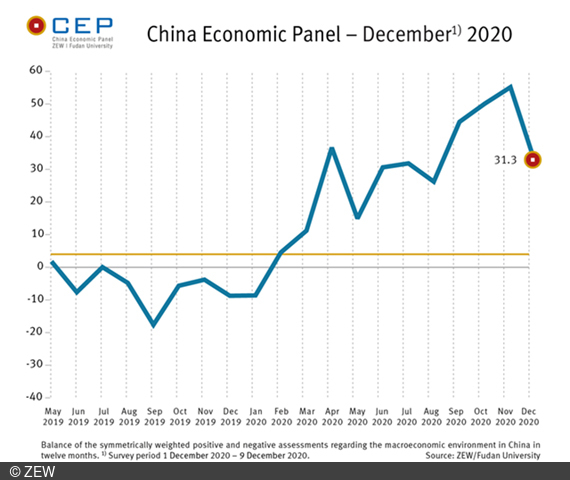Outlook for China Remains Very Positive
China Economic PanelCEP Indicator Currently Stands at 31.3 Points
In the December survey (1–9 December 2020), the CEP indicator decreased by 23.7 points to a new reading of 31.3 points. Although this marks a sharp decline, expectations are still at a historically high level. The CEP indicator, based on the China Economic Panel (CEP) in cooperation with Fudan University, Shanghai, reflects the economic expectations of international financial market experts for China on a 12-month basis.
The assessment of the current economic situation again rose significantly. The corresponding indicator gained 13.8 points and climbed to a level of 43.8 points, reaching the highest value since the survey began in 2013. “The outlook according to both the CEP indicator and the situation indicator remains very positive. For the coming year 2021, the experts expect growth rates to return to Chinese pre-COVID-19 levels,” comments Dr. Michael Schröder, researcher in the “International Finance and Financial Management” Research Department at ZEW Mannheim, on the survey results.
State measures to support the economy expected to continue
With a few exceptions – in construction and among service providers – the assessments of the individual sectors have improved very significantly. At the top of the list is the chemicals/pharmaceuticals sector, which is likely to benefit in particular from increased demand for vaccines against the coronavirus. However, earnings are also expected to develop at a high level in the other sectors. The majority of experts continue to expect a further increase in both government consumption and domestic debt. They thus predict a continuation of the government’s interventionist economic policy.
“With regard to the major economic regions, it is becoming increasingly apparent that the importance of Hong Kong is likely to decline significantly. For some time now, expectations concerning the development of Hong Kong’s economic output have been in negative territory. This contrasts sharply with expectations for the economic region of Shenzhen, for example, which is located close to Hong Kong,” says Michael Schröder. This result is supported by the forecast for real estate prices. While the corresponding indicator for Hong Kong has been strongly negative for months, signaling a decline in property prices, Shenzhen is expected to see a sharp increase.
